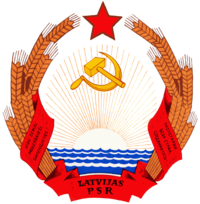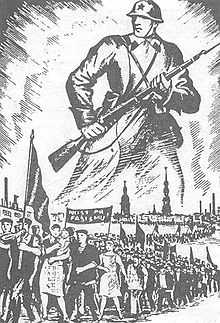- Communist Party of Latvia
-
Communist Party of Latvia
Latvijas Komunistiskā partija
Founded 1904 Dissolved 1991 Headquarters Riga Newspaper Latvijas patiesība Ideology Communism,
Marxism-LeninismPolitical position Far-left European affiliation None European Parliament Group None Official colours Red Politics of Latvia
Political parties
ElectionsCommunist Party of Latvia (Latvian: Latvijas Komunistiskā partija; LKP) was a political party in Latvia.
Latvian Social-Democracy prior to 1919
The party was founded at a congress in June 1904.[1] Initially the party was known as the Latvian Social Democratic Workers' Party (LSDSP). During its second party congress in 1905 it adopted the programme of the Russian Social Democratic Labour Party (RSDLP) as its own. At the Fourth Congress of the RSDLP in 1906, the LSDSP entered the RSDLP as a territorial organisation, and after the congress its name was changed Social-Democracy of the Latvian Territory.[2]
The party held its fourth congress in Brussels January 26 to February 8, 1914.[1]
Rule in Soviet Latvia, 1919–1920
The party briefly governed the Latvian Socialist Soviet Republic in 1919; and changed its name to the Communist Party of Latvia in March 1919; 7,500 members in 1919.[3] The youth wing of the party was the Young Communist League of Latvia (LKJS).
The LKP was a member of the Comintern (Third International) from 1919.
Underground and exile, 1920–1940
In the aftermath of the Latvian War of Independence, the LKP was banned in Latvia. Its leadership resided in exile in the USSR, while the organisation in Latvia operated clandestinely, either through underground cells, or via proxy organisations, such as "Red" leftist trades unions.
In 1936, a youth organization parallel to the LKJS, Workers' Youth League of Latvia (LDJS), was formed as a cooperative effort by the LKP and their former rivals, the erstwhile Menshevik Latvian Social Democratic Workers' Party, outlawed following the Ulmanis coup d'état in 1934.
In power in the Latvian SSR, 1940–1990
After the entry of the Soviet Army to Latvia in June 1940 and the ousting of the Ulmanis government, the LKP and LDJS were legalised again and could operate openly.[4]
In 1940 the party was merged into the Communist Party of the Soviet Union (Bolsheviks). As the Latvian branch of CPSU(b) it was renamed as Communist Party of Latvia (Bolshevik) (Latvian: Latvijas Komunistiskā (boļševiku) partija, (LK(b)P). When the CPSU(b) was renamed the Communist Party of the Soviet Union in 1952, the Latvian branch was reconstituted under the old name LKP.[4]
On 14 April 1990, a pro-independence faction under Ivars Ķezbers split off from the LKP to form the Independent Communist Party of Latvia (Latvian: Latvijas Neatkarīgā komunistiskā partija). The main body of the LKP, under the chairmanship of Alfrēds Rubiks, remained loyal to Moscow and the CPSU leadership. Later that same year, on 14 September, Ķezbers's party was officially renamed the Democratic Labour Party of Latvia (Latvian: Latvijas Demokrātiskā darba partija, LDDP) and adopted nominally social-democratic platform.
Article 6 of the Latvian SSR Constitution (1977) made the LKP's monopoly on political power in Soviet Latvia explicit. In 1990, the Supreme Council of the Republic of Latvia (formerly the Latvian SSR Supreme Soviet, now dominated by the Latvian Popular Front) voted to remove Article 6 from the Constitution.
Post-independence, 1990–1994
Following Latvia's renewed independence from the Soviet Union, the LKP was banned by a decision of the Supreme Council of the Republic of Latvia on 10 September 1991 as an organisation deemed hostile to Latvia's independence.
In 1994, the Socialist Party of Latvia was founded as the successor to the LKP.
Press
Cīņa (Struggle) was a newspaper founded in March 1904 as the Central Organ of the Latvian Social-Democrats. It was published periodically in Riga, Brussels and Petrograd. From 1919 it was the organ of the Communist Party of Latvia.[5]
While the LKP leadership was in exile in the USSR during the interwar years and the Nazi occupation in World War II, Cīņa was published in the Russian SFSR. From 1940 onwards it was published in Riga.
In the Latvian SSR, Cīņa was one of the main Latvian-language dailies. In 1990, when the Ķezbers faction split from the main LKP to form the Independent Communists, they changed the name of the newspaper to Neatkarīgā Cīņa (The Independent Struggle), which after privatisation in the 1990s later became Neatkarīgā Rīta Avīze.
The Russian-language sister publication to Cīņa published by the LKP was the daily Sovetskaya Latviya (Soviet Latvia); while the daily Padomju Jaunatne (Soviet Youth) was the newspaper of the Latvian Young Communist League.
In the Latvian SSR, the LKP also published a monthly political journal Padomju Latvijas Komunists (Communist of Soviet Latvia, ISSN 0132-6430; in the 1940s and '50s: Padomju Latvijas Boļševiks), with a parallel edition in Russian (Kommunist Sovetskoi Latvii, ISSN 0321-2092). The journal ceased publication in 1990.
First Secretaries of the Communist Party of Latvia
Jānis Kalnbērziņš: 25 August 1940–November 25, 1959 (in Russian SFSR exile, 1941–1944) Arvīds Pelše: November 25, 1959–April 15, 1966 Augusts Voss: April 15, 1966–April 14, 1984 Boriss Pugo: April 14, 1984–October 4, 1988 Jānis Vagris: October 4, 1988–April 7, 1990 ("Leading" role of the party abolished January 11, 1990) Alfrēds Rubiks: April 7, 1990–August 24, 1990 Second Secretaries of the Communst Party of Latvia
Žanis Spure August–December 1940 Ivan Lebedev 1944–January 1949 Fedor Titov January 1949–-1952 ? Valentin Ershov 1952 ?–June 1953 Vilis Krūmiņs June 1953–January 1956 Filipp Lashnikov January 1956–January 1958 ? Arvīds Pelše January–April 1958 ? Vilis Krūmiņs April 1958 ?–February 1960 Mikhail Gribkov February 1960–1963 Nikolai Belukha 1963-1978 Igor Strelkov 1978-1980 Valentin Dmitriev 1980-1986 Vitaly Sobolev 1986-1990 See also
References
Categories:- Banned communist parties
- Branches of the Communist Party of the Soviet Union
- Communist parties in Latvia
- Political parties established in 1904
- Political parties disestablished in 1991
- Defunct political parties in Latvia
Wikimedia Foundation. 2010.

